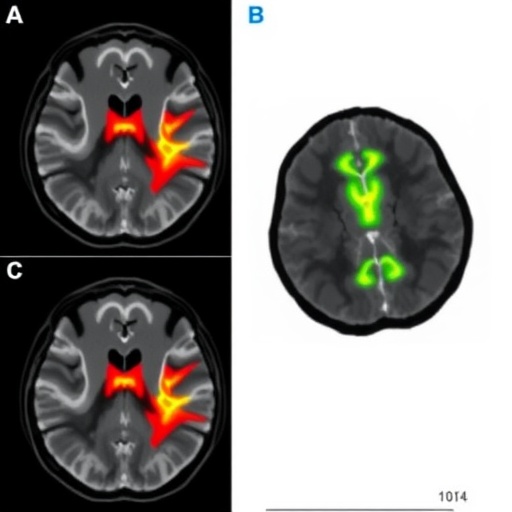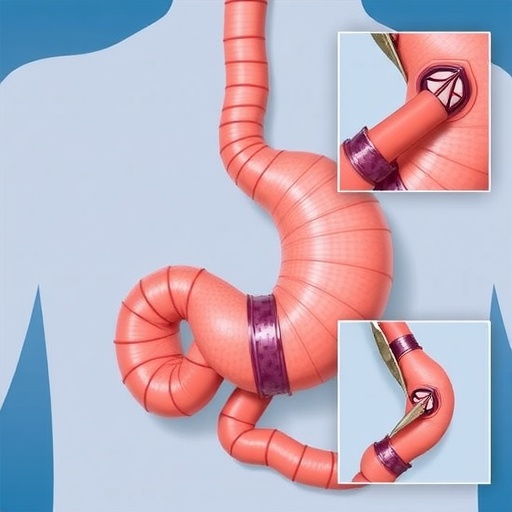In an era where the molecular intricacies of cancer continue to unravel revealing unprecedented opportunities for targeted therapy, a recent study published in BMC Cancer unveils transformative insights into breast cancer progression. The research focuses on Collagen Triple Helix Repeat Containing 1 (CTHRC1), a protein whose palmitoylation status and spatial distribution within tumor tissues orchestrate a complex biological landscape that drives malignancy. By harnessing advanced multi-omics data analysis and cutting-edge machine learning algorithms, this investigation not only decodes the molecular dialogue underpinning tumor development but also paves the way for novel diagnostic and therapeutic strategies.
Breast cancer remains a formidable challenge in oncology, characterized by its heterogeneity and dynamic tumor microenvironment. In the present study, investigators meticulously screened a vast array of genes associated with palmitoylation—a crucial post-translational modification that attaches lipid moieties to proteins, modulating their localization, stability, and function. The comprehensive analysis, refined by batch effect correction through the ComBat algorithm, identified 1,782 differentially expressed genes (DEGs), revealing profound enrichment in pathways related to extracellular matrix remodeling and PI3K-Akt signaling. These pathways are instrumental in regulating cellular interactions and survival mechanisms, underpinning the aggressive behavior of cancer cells.
Employing three distinct machine learning methods, the researchers distilled the complexity of these DEGs to isolate five core genes—HBB, BGN, CTHRC1, FABP4, and CD34—fundamental to breast cancer pathophysiology. Among these, CTHRC1 emerged as the pivotal gene, with SHAP (SHapley Additive exPlanations) interpretability analyses identifying it as the dominant factor influencing predictive models of disease progression. This reinforces the hypothesis that CTHRC1 is not merely a bystander but a main driver of tumor aggressiveness.
What sets this study apart is its integration of spatial transcriptomics, a revolutionary technique that maps gene expression within the architectural context of intact tissue sections. The team discovered that tumor regions exhibiting focal overexpression of CTHRC1 corresponded with heightened microenvironmental heterogeneity, suggesting that the spatial distribution of this protein influences tumor micro-niches. This heterogeneity is known to facilitate immune evasion, therapeutic resistance, and metastatic potential, which complicates clinical management.
Functional validation experiments further substantiated the role of CTHRC1 in breast cancer. Silencing CTHRC1 expression significantly impaired cellular proliferation and clonogenic potential, affirming its function as a facilitator of tumor growth. These insights into the biological role of palmitoylated CTHRC1 illuminate a previously underexplored axis of cancer progression, hinting at the modulation of lipid modifications as a novel therapeutic avenue.
The emphasis on palmitoylation networks contributes a critical layer to understanding cancer biology. Palmitoylation modifies proteins via the covalent attachment of palmitic acid, influencing their trafficking and membrane association. The aberrant palmitoylation of CTHRC1 appears to enhance its oncogenic capacities, amplifying tumor cell signaling and fostering an environment conducive to malignancy. Targeting this modification presents a promising strategy to disrupt tumor-supportive pathways.
Intriguingly, the diagnostic potential of CTHRC1 is underscored in this research. Its consistent overexpression and critical involvement in model predictions highlight it as a viable biomarker. The possibility of developing liquid biopsies that detect palmitoylated CTHRC1 could revolutionize early detection and real-time monitoring of breast cancer, enhancing personalized medicine. Non-invasive diagnostic tools offer considerable clinical benefits by improving patient compliance and facilitating dynamic treatment adjustments.
Moreover, the therapeutic implications are profound. As the palmitoylation status of CTHRC1 modulates its function, pharmacological agents designed to inhibit palmitoylation enzymes or disrupt CTHRC1 interactions could attenuate tumor progression. Such targeted therapies promise to minimize off-target effects, offering patients treatments with enhanced efficacy and reduced toxicity.
This study bridges molecular biology and clinical application, revealing the spatial heterogeneity of tumors not only as a structural phenomenon but as a functional driver of cancer progression. The intricate crosstalk within the tumor microenvironment, influenced by palmitoylated proteins like CTHRC1, represents an important frontier in cancer research. Therapeutic interventions aimed at these microenvironmental factors could inhibit tumor evolution and metastasis, improving patient survival rates.
Importantly, the integration of multi-omics data through sophisticated machine learning models marks a paradigm shift in oncology research. By leveraging genomic, transcriptomic, and proteomic datasets, the study demonstrates how computational approaches can distill complex biological signals into clinically actionable insights. This convergence of data science and molecular oncology propels the field toward more precise and predictive medicine.
In conclusion, the elucidation of CTHRC1’s role in breast cancer underscores the critical influence of post-translational modifications and spatial gene expression patterns on tumor biology. The findings herald an era where targeting protein palmitoylation and understanding microenvironmental heterogeneity could drastically alter breast cancer prognosis and treatment. As research continues to explore these mechanisms, collaborations between computational biologists, molecular oncologists, and clinical practitioners will be essential to translate these insights into groundbreaking therapies.
Such comprehensive studies are vital in overcoming the persistent challenges posed by tumor heterogeneity and resistance mechanisms. By illuminating the molecular drivers like CTHRC1 within breast cancer’s complex ecosystem, this research ultimately contributes to the ambitious goal of transforming breast cancer from a deadly disease into a manageable condition through precision medicine.
As the field advances, the implications extend beyond breast cancer itself, offering a template to investigate similar mechanisms in other malignancies. The modulation of protein palmitoylation and the harnessing of spatial transcriptomics may soon become foundational techniques in oncology, bringing personalized treatments within reach for countless patients worldwide.
The pioneering work demonstrated here not only enriches scientific knowledge but also galvanizes hope—a testament to the extraordinary potential unlocked when innovative technology meets focused clinical inquiry. The future of cancer treatment may very well hinge on such interdisciplinary endeavors that bridge cellular biology, bioinformatics, and translational medicine.
Subject of Research: Palmitoylation networks and spatial heterogeneity in CTHRC1-driven breast cancer progression.
Article Title: CTHRC1-driven breast cancer progression: insights from palmitoylation networks and spatial heterogeneity
Article References: Yu, S., Wu, J. CTHRC1-driven breast cancer progression: insights from palmitoylation networks and spatial heterogeneity. BMC Cancer 25, 1795 (2025). https://doi.org/10.1186/s12885-025-15190-w
Image Credits: Scienmag.com
DOI: 10.1186/s12885-025-15190-w (Published 21 November 2025)
Tags: breast cancer research advancementsCTHRC1 protein in breast cancerdiagnostic strategies for breast cancerextracellular matrix remodeling in tumorsgene expression analysis in tumorsmachine learning in cancer researchmulti-omics data analysis in oncologypalmitoylation and cancer progressionPI3K-Akt signaling pathway in breast cancerpost-translational modifications in cancertherapeutic strategies for malignancytumor microenvironment and heterogeneity





